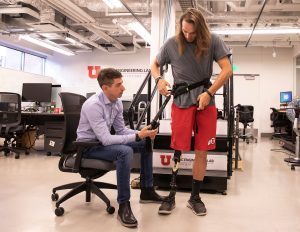Though autonomously powered hip exoskeletons have been shown to reduce the metabolic cost of—or the energy demands associated with—walking in young people without an amputation, their use by people with transfemoral amputations has not yet been tested.
Researchers from the Department of Mechanical Engineering and Robotics, University of Utah, tested the efficacy of a powered hip exoskeleton for six people (four men, two women; average age of 33.8 years) with transfemoral amputations, as they walked on a treadmill at a speed of one meter per second, as well as walking on a 12m walkway. The authors of the study found that compared with the metabolic cost of using a standard prosthesis, using the hip exoskeleton, on average, reduced the metabolic cost of walking by 15.6 percent, an improvement equivalent to removing a 26.4-pound backpack from a person without an amputation. All participants were additionally able to walk with the exoskeleton without a negative effect on their gait, according to the study.

The study found that assistance of the user’s residual limb with a powered hip exoskeleton is a viable solution for improving walking economy for those with lower-limb amputations. The authors also indicated the need for future clinical studies to optimize the device and to assess its efficacy for people with different types of amputation and with varying potential for rehabilitation.
The study was published in October in Nature Medicine.




